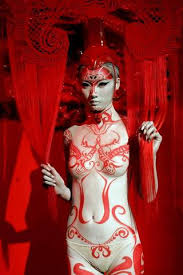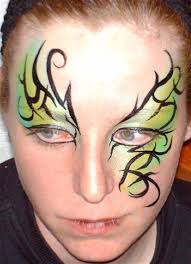
Body Painting - The Intricacies
The origin of body painting is unknown, but its use has been widespread - sometimes as an art form, sometimes as a part of tradition, and the other times, as a necessity. The evidence of body painting is found in ancient practices across various cultures and remains a popular fashion statement in the present times. There is no set style or technique for body painting. It can be a localized design or a fuller one, covering the entire body in some cases. The color pigments used can be natural or synthetic. Similarly, it can be a work of an expert or an amateurish hand of a novice. However, unlike permanent tattoos, body paints are temporary or semi-permanent in nature.

The Geographical Spread
Painting the body was prevalent in ancient Egyptian civilization, where Pharaohs and high-class individuals painted their faces in red ochre & white pigments, and eyes in kohl. The Himba group of Namibia also generously uses red ochre. These people paint their entire bodies in the uniform pigment, as a traditional practice. In India, body painting is an elaborate work of expertise, which requires training and a lot of experience. One of the best examples of this art is the make-up of Kathakali dancers that involves the use of white, red, black, and yellow colors against a base of bottle green color, on face.

The use of 'henna,' a natural plant extract, is very popular among the Indian women across the country and is again, done by trained experts. Henna is used for decorating the hands and feet in beautiful, complex designs. Native Americans use streaks, concentric circles, and other patterns of colors, which include red, white, yellow, blue, and black. The indigenous Yolngu people of Australia use detailed and painstaking technique to embellish their bodies. It is an inspiration for many other art forms and a job that only the experts can do.Painted faces have been a trademark of comedians and mimics, throughout the history of performing arts. Body painting has found as much use in military operations, as in local communities. Facial colors, particularly in nature tones are heavily employed as camouflage by almost all armies in the world. Now days, this art has become a fad, especially among the youth and is treated more as an avant-garde fashion accessory, rather than as a religious belief. Across the US and Europe, body painting is used in theatre, cinema, fashion, carnivals, and body painting festivals. Despite facing criticism and rejection from various corners, this art continued to grow and is still evolving!



 Gallery Art Brasil Flags Body Painting
Gallery Art Brasil Flags Body Painting Gallery Art Argentina Flags Body Painting
Gallery Art Argentina Flags Body Painting Gallery Art Swedia Flags Body Painting
Gallery Art Swedia Flags Body Painting Gallery Art England Flags Body Painting
Gallery Art England Flags Body Painting